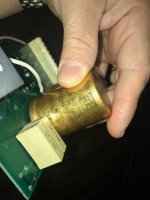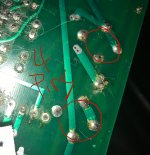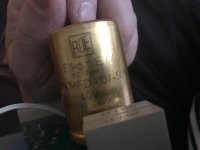Hello,
I have a power supply tranny and two dual mono PS boards from Electrocompaniete AW50.
I would like to use it on another project. The capacitors are 4pin Roe Elna 10000mf 40V.
Any way I can test them to see if they are still good?
Or should I replace them with other capacitors since they are at least 30 yo? would be very helpful if someone recommend how to hook up normal 2 pin ones in this layout, if it is even possible.
any recommendation would be appreciated.
I have a power supply tranny and two dual mono PS boards from Electrocompaniete AW50.
I would like to use it on another project. The capacitors are 4pin Roe Elna 10000mf 40V.
Any way I can test them to see if they are still good?
Or should I replace them with other capacitors since they are at least 30 yo? would be very helpful if someone recommend how to hook up normal 2 pin ones in this layout, if it is even possible.
any recommendation would be appreciated.
Attachments
Would you use 30 year old tires? The seal is rubber, except for certain green CDE caps from that era sealed with epoxy, and some mythical Sprague epoxy sealed caps never even described to me by an actual observer.
Just because the ESR is fine, doesn't mean the rubber won't break and leak out any fluid left tomorrow if they get warm. Oxygen never sleeps.
You can measure ESR with a $120 Peak ESR meter, which has a general ESR limit table in the manual. In general, I've found it not worth the trouble. Ripple out @ rated current is easier to measure with a $29 DVM. Water content is unmeasurable unless you have some unused caps of the same type & batch for reference.
The 4 pins are for rough handling, not anything electrical. Usually people replace 4 pin capacitors with some 2 pins ones and some hot melt glue. You look at the diode bridge output and the output terminal polarity markings, to see which go to plus & which to go minus.
Just because the ESR is fine, doesn't mean the rubber won't break and leak out any fluid left tomorrow if they get warm. Oxygen never sleeps.
You can measure ESR with a $120 Peak ESR meter, which has a general ESR limit table in the manual. In general, I've found it not worth the trouble. Ripple out @ rated current is easier to measure with a $29 DVM. Water content is unmeasurable unless you have some unused caps of the same type & batch for reference.
The 4 pins are for rough handling, not anything electrical. Usually people replace 4 pin capacitors with some 2 pins ones and some hot melt glue. You look at the diode bridge output and the output terminal polarity markings, to see which go to plus & which to go minus.
Last edited:


